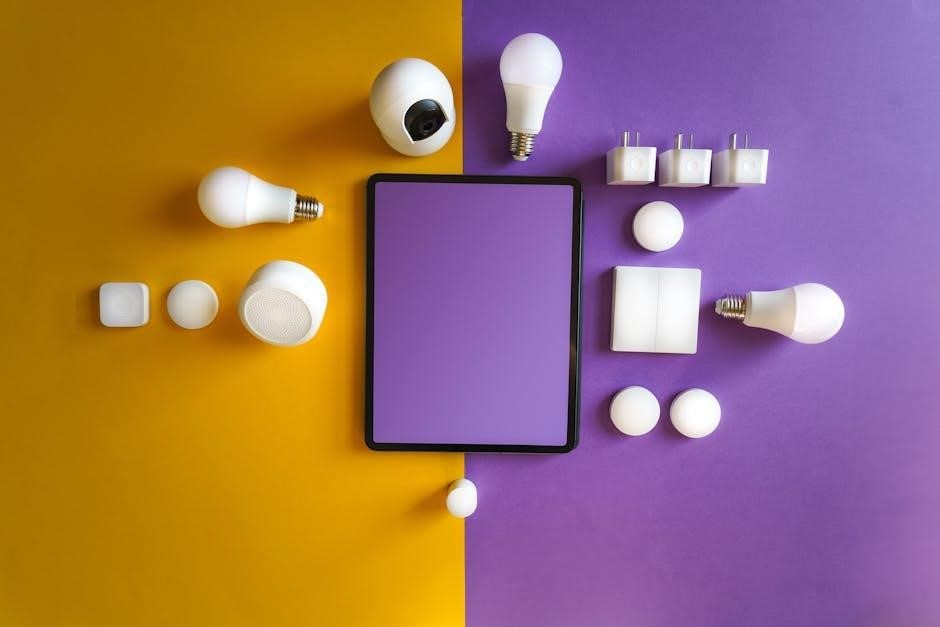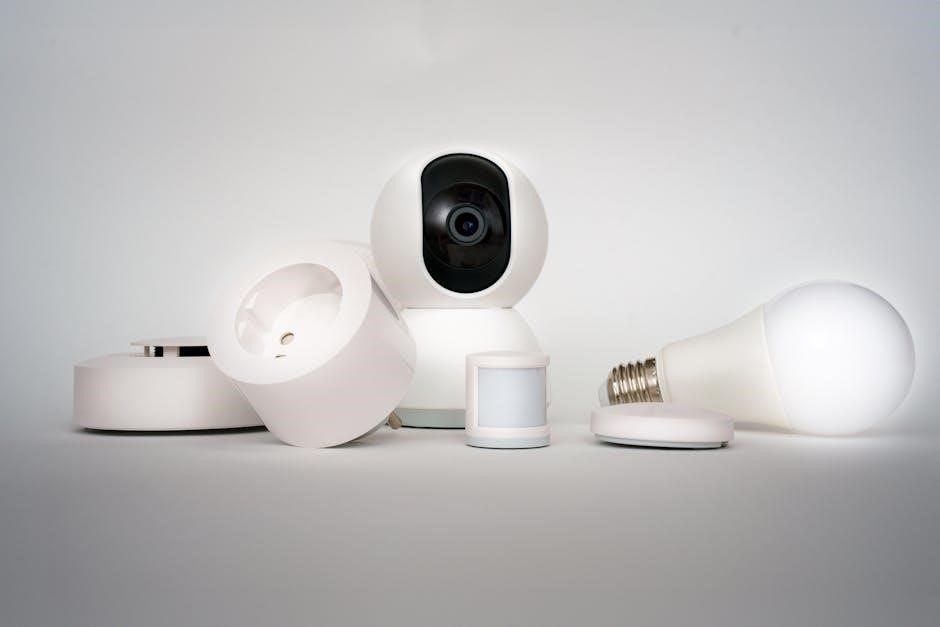Motion sensor light switches with manual override combine automation and control, offering energy efficiency and convenience. They detect movement to turn lights on/off and allow manual operation for flexibility.

What is a Motion Sensor Light Switch?
A motion sensor light switch is a device that automatically controls lighting based on detected movement. It uses infrared or passive infrared sensors to detect motion and turn lights on/off. This switch combines convenience, energy efficiency, and security, ideal for hallways, staircases, and outdoor spaces. Some models include a manual override feature, allowing users to bypass the sensor for permanent lighting control when needed, ensuring flexibility in various situations.
Why Manual Override is Important
Manual override functionality in motion sensor switches provides users with direct control over lighting, ensuring flexibility in various situations. It allows disabling the sensor temporarily, which is useful for tasks requiring constant light or during events where motion detection might cause frequent switching. This feature enhances convenience, prevents unnecessary interruptions, and offers a reliable backup option when the sensor malfunctions, making it an essential component for practical and efficient lighting control systems.

Types of Motion Sensor Light Switches
Motion sensor light switches are available as standalone units, smart home integrated systems, or hardwired/wireless options, catering to diverse installation and functionality preferences for enhanced convenience.
Standalone Motion Sensor Switches
Standalone motion sensor switches operate independently without requiring a central hub or complex setup. They are easy to install and offer features like adjustable sensitivity and timer settings. These switches are ideal for spaces where automated lighting is desired but without smart home integration. They provide energy efficiency by automatically turning lights off when no motion is detected, while also offering manual override for user control. This makes them versatile for various applications, from residential to commercial use.
Smart Home Integrated Motion Sensor Switches
Smart home integrated motion sensor switches seamlessly connect to popular platforms like Alexa or Google Home, enabling voice control and remote operation via smartphone apps. These switches enhance convenience by integrating with other smart devices, allowing automated lighting scenes and energy-saving routines. They often feature advanced settings, such as customizable motion sensitivity and timers, while retaining manual override functionality for times when automation isn’t desired. This integration boosts home security and efficiency, making them a top choice for modern households.
Hardwired vs. Wireless Motion Sensor Switches
Hardwired motion sensor switches are installed directly into your home’s electrical system, offering reliability and a permanent solution. Wireless options, however, provide flexibility and easier installation without wiring. Hardwired switches are ideal for new constructions or major renovations, while wireless models suit rentals or spaces where wiring is inconvenient. Both types often include manual override functionality, allowing users to switch between automated and manual control as needed for convenience and energy efficiency.

How to Choose the Right Motion Sensor Light Switch
Selecting the right motion sensor light switch involves considering factors like installation location, sensor range, manual override functionality, compatibility with lighting types, energy efficiency, brand reputation, and cost. Evaluate your specific needs to ensure the switch aligns with your lifestyle and home setup for optimal performance and convenience.
Key Features to Consider
When selecting a motion sensor light switch with manual override, consider sensitivity, detection range, and delay timing for optimal performance. Ensure compatibility with your lighting type, such as LED or smart bulbs. Check for energy efficiency ratings and smart home integration capabilities. Evaluate the power source—hardwired or battery-powered—and assess durability for long-term use. Manual override functionality should be intuitive, allowing seamless control when automation is unnecessary. Additionally, consider warranty and customer support for reliability and peace of mind.

Factors Affecting Sensor Accuracy and Reliability
Sensor accuracy and reliability depend on sensitivity, detection range, and delay timing. Environmental factors like lighting conditions, temperature, and humidity can impact performance. Proper installation location and angle are crucial to avoid false triggers. Additionally, compatibility with lighting types, such as LED or smart bulbs, ensures smooth operation. Regular cleaning of sensors and avoiding obstructions like dust or furniture placement can maintain optimal functionality. High-quality sensors with advanced algorithms provide better reliability and consistent performance over time.
Manual Override Functionality Explained
The manual override feature allows users to control lighting independently of motion detection. This ensures flexibility, enabling lights to stay on or off as needed. It’s ideal for tasks requiring constant illumination or for scenarios where motion sensing isn’t desired. The override typically works via a switch or smart app, providing seamless integration with automated systems. This dual functionality enhances convenience and customization, catering to various user preferences and situations.
Installation and Setup Guide
Installing motion sensor light switches involves turning off power, connecting wires, and placing the sensor. Ensure proper alignment and test functionality post-installation for optimal performance and reliability.
Where to Install Motion Sensor Light Switches
Motion sensor light switches are ideal for hallways, staircases, garages, and outdoor spaces like patios or driveways. They enhance security and convenience in high-traffic areas. Install them in areas where hands-free lighting is beneficial, such as near entryways or in rooms with frequent use. Ensure sensors are placed away from direct sunlight or heat sources to avoid false triggers. Proper placement at an optimal height and angle ensures accurate motion detection and reliable performance.
Step-by-Step Installation Process
Begin by turning off the power supply to the circuit at the breaker box. Remove the old switch and connect the motion sensor switch wires to the corresponding terminals. Mount the sensor unit securely, ensuring it faces the desired detection area. Adjust sensitivity and timer settings as needed. Turn the power back on and test the sensor’s range and manual override functionality. Ensure all connections are secure for reliable operation and safety.

Troubleshooting Common Issues
Identify sensor malfunctions, connectivity issues, or manual override failures. Check power supply, wiring connections, and sensor alignment. Adjust sensitivity settings or clean the sensor for optimal performance.
Why Your Motion Sensor Might Not Be Working
Your motion sensor might fail due to power outages, faulty wiring, or sensor misalignment. Dirt, dust, or obstructions can block detection. Check connections, clean the sensor, and ensure proper installation. Adjust sensitivity settings if needed. Verify that manual override functions correctly. If issues persist, consult the manufacturer’s guide or consider replacing the sensor. Regular maintenance can prevent such problems and ensure reliable performance.
Fixing the Manual Override Function
If the manual override isn’t working, check the power supply and wiring connections. Ensure the switch is properly installed and aligned with the sensor. Clean the sensor to remove dirt or debris. Reset the switch by turning it off and on again. Consult the user manual for specific instructions. If issues persist, replace the switch or contact a professional. Regular testing ensures the override function works seamlessly with the motion sensor.

Maintenance and Care Tips
Regularly clean the sensor and switch to ensure optimal performance. Check wiring connections and replace batteries if needed. Ensure proper alignment for accurate motion detection and manual override functionality.
How to Clean and Maintain Motion Sensors
Regularly clean the motion sensor with a soft cloth to remove dust and dirt. Ensure proper alignment and avoid direct sunlight interference. Check for obstructions and tighten connections. Use compressed air for gentle cleaning and avoid harsh chemicals. Test the sensor after cleaning to ensure accuracy. Maintain the manual override feature by checking its functionality periodically. Proper maintenance ensures reliable operation and extends the lifespan of your motion sensor light switch.
Extending the Lifespan of Your Switch
To extend the lifespan of your motion sensor light switch, ensure proper installation and avoid loose connections. Use high-quality components and protect the switch from power surges. Regularly clean the sensor to prevent dust buildup and maintain optimal performance. Avoid exposing the switch to extreme temperatures or humidity. Follow manufacturer guidelines for maintenance and replace worn-out parts promptly. Proper care ensures reliable operation and maximizes the durability of your motion sensor light switch with manual override.
Safety and Security Benefits
Motion sensor light switches enhance security by detecting movement and deterring intruders. They improve safety by reducing accidents in low-light areas and offer manual override for control.
Enhancing Home Security with Motion Sensors
Motion sensor light switches with manual override boost home security by detecting movement and activating lights, deterring intruders. The sudden illumination startles potential trespassers, making them feel exposed. Manual override ensures control during sensor malfunctions or false triggers, maintaining reliability. This dual functionality enhances safety and peace of mind, offering both automated and manual security solutions for homeowners.
Preventing Accidents with Automated Lighting
Motion sensor light switches with manual override reduce accident risks by providing automated lighting in low-visibility areas. They ensure lights turn on instantly upon detecting movement, preventing trips or falls in dark spaces. The manual override feature allows users to adjust lighting when needed, offering a reliable backup for sensor operation. This combination enhances safety, especially in stairways, hallways, and outdoor paths, where unexpected movements can lead to accidents.

Energy Efficiency and Cost Savings
Motion sensor light switches with manual override enhance energy efficiency by reducing unnecessary light usage and lowering utility bills through automated and controlled operation.
How Motion Sensors Reduce Energy Consumption
Motion sensors reduce energy consumption by automatically turning lights on/off based on occupancy, eliminating manual operation errors. They minimize unnecessary illumination, cutting wasted energy and lowering utility bills. Programmable timers and brightness adjustments further optimize usage, ensuring lights operate only when needed. This smart automation leads to significant long-term cost savings and extended bulb lifespan, promoting a more sustainable and efficient home environment.
Long-Term Cost Benefits of Manual Override Switches
Manual override switches offer long-term cost savings by allowing users to bypass motion sensors when needed, reducing unnecessary energy consumption. This feature prevents constant switching, extending bulb lifespan. By minimizing false activations and enabling manual control, these switches lower electricity bills and maintenance costs, providing a sustainable solution for energy-efficient homes while maintaining convenience and functionality.

Integration with Smart Home Systems
Motion sensor light switches with manual override integrate seamlessly with smart home systems, enabling voice control and remote access through platforms like Alexa and Google Home, enhancing convenience and control.
Compatibility with Popular Smart Home Platforms
Motion sensor light switches with manual override are compatible with leading smart home systems like Alexa, Google Home, and Apple HomeKit. This integration allows seamless voice control and remote operation through smartphone apps. Users can effortlessly switch between automated and manual modes, ensuring flexibility and convenience. Compatibility ensures enhanced functionality, enabling homeowners to customize lighting preferences while maintaining energy efficiency and smart home connectivity.
Controlling Lights Remotely with Manual Override
Motion sensor light switches with manual override offer remote control through smart home apps, allowing users to toggle lights on/off or switch modes from anywhere. This feature enhances convenience, especially when combined with voice assistants. The manual override ensures seamless transitions between automated and manual operation, providing flexibility and reliability. Remote control capabilities make it ideal for smart home enthusiasts seeking efficient lighting solutions without compromising on ease of use.

Cost and Return on Investment
Motion sensor light switches with manual override offer a balance of initial cost and long-term savings through reduced energy consumption and extended bulb lifespan, enhancing ROI.
Initial Investment vs. Long-Term Savings
While motion sensor light switches with manual override may have a higher upfront cost, they offer significant long-term savings by reducing energy consumption and extending bulb lifespan. The automated features minimize unnecessary lighting usage, lowering utility bills over time. Additionally, the manual override function provides flexibility, reducing the need for frequent switch replacements. This balance of convenience and efficiency ensures a strong return on investment for homeowners.
Comparing Prices of Different Models
Prices for motion sensor light switches with manual override vary based on features, brand, and technology. Basic models start around $20, while advanced smart home-integrated options can exceed $100. Factors like sensor range, dimming capabilities, and wireless connectivity influence cost. Comparing models ensures you find the best value for your needs, balancing initial investment with long-term energy savings and convenience.
User Reviews and Ratings
Customers praise motion sensor light switches for their convenience and energy savings. Many highlight ease of installation and reliability, though some note occasional sensor sensitivity issues.
What Customers Say About Motion Sensor Switches
Customers often praise motion sensor switches for their convenience, energy efficiency, and ease of installation. Many appreciate the manual override feature, which provides flexibility in lighting control. However, some users report issues with sensor sensitivity and occasional false triggers. Overall, these switches are well-received for their ability to enhance home security and reduce energy consumption, making them a popular choice for modern households seeking smart lighting solutions.
Top-Rated Models with Manual Override
Top-rated motion sensor light switches with manual override are praised for their reliability and functionality. Models like the Lutron Caséta and Leviton Decora are favorites, offering seamless integration with smart home systems. These switches combine energy efficiency with advanced features like adjustable sensitivity and timers. Users highlight their durability and ease of use, making them ideal for modern homes seeking convenience and control over lighting systems.
Future Trends in Motion Sensor Technology
Future trends include advancements in sensor accuracy, integration with emerging smart home technologies, and enhanced energy efficiency, ensuring smarter and more seamless lighting control solutions.
Advancements in Sensor Accuracy
Advancements in sensor accuracy are revolutionizing motion sensor technology, with improved detection capabilities and reduced false triggers. Enhanced algorithms and AI integration enable better sensitivity and coverage, ensuring reliable performance. These upgrades minimize unnecessary activations and optimize energy efficiency, making motion sensor light switches more effective and user-friendly. Future developments promise even greater precision, adapting to various environments and user preferences seamlessly.
Integration with Emerging Smart Home Technologies
Motion sensor light switches are increasingly integrating with smart home systems, offering seamless control through voice assistants and mobile apps. Compatibility with platforms like Alexa and Google Home enhances functionality, allowing users to customize settings and routines. This integration enables remote monitoring and energy management, making homes smarter and more efficient. As smart technology evolves, these switches will continue to adapt, providing even greater convenience and connectivity for modern living.
Motion sensor light switches with manual override offer a perfect blend of energy efficiency, convenience, and smart integration, making them a future-proof solution for modern homes.
Final Thoughts on Motion Sensor Light Switches
Motion sensor light switches with manual override are a practical and efficient solution for modern homes. They offer the convenience of automation while providing the flexibility of manual control, ensuring energy savings and enhanced security. With advancements in technology, these switches are becoming more reliable and user-friendly, making them a worthwhile investment for homeowners seeking to balance comfort, safety, and sustainability in their living spaces.
Recommendations for Potential Buyers
When selecting a motion sensor light switch with manual override, consider features like sensor accuracy, override functionality, and smart home integration. Ensure compatibility with your existing lighting system and check reviews for reliability. Opt for energy-efficient models to maximize savings. Balance automation with manual control for enhanced convenience and security, making it a practical upgrade for modern homes seeking to optimize lighting solutions effectively.
